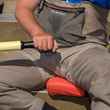I remember packing up at the trailhead of a small tributary to the South Fork of the Snake River that fateful evening some two decades ago. It was nearly dark, and the mosquitoes were on me the second I removed my waders. The sun had dropped below the Big Hole Mountains, and everything took on a chill that’s universal in the Rockies.
No sun. No warmth. We don’t get those sultry Southern evenings here in the mountains. When the sun goes behind the mountains, it steals the heat from the river bottoms. And the bugs come out. Sucks to be you if you’re caught out in it.
And you do desperate things when the blood-suckers find you. You rush. Maybe you just throw your wet waders in the truck bed. And your wet boots. No folding. No strategic placement. Perhaps you quickly break down the rod, but you don’t tie the sock, choosing instead to retreat to the truck cab for a gulp of water and some relative safety from the soul-sucking insects that drained your blood and your spirit in just mere minutes.
An amazing day of native cutthroat fishing had ended, followed by a harried fall-back to the truck. All packed up, it was time to head home — a 90-minute drive in the dark.
But this story really begins at a pawn shop in Pocatello, Idaho. There, in the bargain barrel, I’d spied a two-piece Scott fiberglass fly rod of unknown lineage — I had no idea how old the implement was, but when I lifted it from the barrel and performed the prerequisite wiggle, I knew I had to have it. Light and noodly, this 6-foot, 2-weight rod could become my favorite little creek rod if I could just get the price I needed to assuage my skinny journalist salary.
Careful to conceal my delight at the “pick,” I nonchalantly walked to the counter.
“How much?” I asked the clerk, hoping against hope that he didn’t know what he had on his hands.
“Hundred bucks,” he replied quickly. I laughed and shook my head. It was masterful.
“Oh, hell no. I’ll give you 40.”
“Sixty.”
“Done.”
Deal of the century.
It came in a little sleeve, but the shop provided no tube. No matter — I crafted a serviceable replacement out of PVC pipe. For two summers, I scarcely lifted another rod — the little Scott was going to be my creek-freak rod of a lifetime.
And then came that fateful evening when the sun dipped behind the mountains and every mosquito in Swan Valley came after me with a vengeance. I have never removed waders and boots so quickly. I’ve never stowed a rod so expediently. The damn bugs were sucking away at the loose threads of my soul, and it was time to get the hell out of there.
And, predictably, I paid for it. For, in my disorganized retreat, I managed to arrive home with an empty rod tube — I remembered leaning the rod against the crossbuck fence at the trailhead as I hastily de-wadered. I didn’t remember, of course, sliding my favorite fishing rod into its sock or stowing it in its tube.
Hell, yes, I drove back to the trailhead. Another 90 angst-ridden minutes. Now, completely dark outside, I drove slowly up the gravel road, hoping that I’d somehow managed to put the rod and reel (a cheap little Pflueger Medalist) on the tailgate and that it had bounced out on the way down to civilization.
Nothing.
I got to the trailhead and shined headlights all around the parking area. I checked the fences. Headlamp shining ahead of me, I looked everywhere.
My favorite little rod was gone. To this day, that pang still rests in my soul. But, lesson learned. I’ll suffer as many bites as it takes, so long as I know I’ve packed up responsibly. But what a lesson.
Then, last fall at the International Fly Tackle Dealer Show in Denver, I ran into my old friend Frank Smethurst. I’ve known Frank for years. He used to host Trout Unlimited’s “On the Rise” TV show back in the day, and he’s been a pro for Scott for as long as I can remember.
Frank put Scott’s newest glass offering in my hands as we caught up at the show — the limber and stunningly beautiful F Series. I was taken aback. The memories of two great summers chasing cutties in the Idaho high country flooded back. Was it possible? Had Scott replaced the perfect small-stream rod with … the even more perfect small-stream rod?
What works
The Glass
Scott’s new F Series is technologically superior to any glass rod the manufacturer has ever crafted — and keep in mind that Scott was a glass pioneer when it was founded in the early 1970s, well before graphite became a fly-rod staple. The company’s new “E-glass” is billed as “an innovative highly unidirectional glass and epoxy composite” that is meant to not only load a bit faster, but recover a tad faster, too. Mission accomplished. As I stood there with Frank at the IFTD casting pond, I was absolutely impressed with how quickly my glass casting memory returned, and how easy it was to load and cast the 2-weight rod. A couple of months later, on a small stream in Patagonia, I cast the little rod to truly large, wild browns and rainbows (likely not the ideal environment for such a waifish fly rod), and came away impressed not only with the rod’s ability to help me cast accurately in close quarters, but to also fight fish in the 16- to 18-inch range. It was an extreme test for such an implement, but I left Argentina even more infatuated with the F Series than I was after the session on the IFTD casting pond.
Short-range accuracy
This is where the F Series really shines. The little 2-weight became an innate extension of my casting arm, and I was floored at how spot-on I was able to cast a sizeable dry fly (I was using a black ant pattern) within about 30 feet of where I stood. What’s more, the rod just felt intuitive — I get that having 30 years of small-stream experience is something not every fly caster is going to have, but I also understand that fishing glass is an exercise in patience, not in power. I honestly believe anyone who’s able to slow their cast a bit and find the rhythm needed to match this rod can become a better, more accurate short-distance caster. Creek freaks rejoice — this rod makes you better. It lets you skip flies under overhanging brush, light a fly in a patch of soft water the size of a basketball hoop and send a longer cast upstream with surprising punch, and on target to boot.
Single-cast loading
Often, because glass rods are quite a bit slower than today’s fast-action graphite and composite rods, they don’t pick up line as quickly or allow for a quick recast. The F Series is the exception, particularly in close quarters. That, of course, is the attraction for anglers who love casting glass — the more time the fly spends on the water, the more chances we have at catching trout. Even in the 2-weight model, the F Series boasts enough backbone to lift, perform a backcast and then recast immediately, with no need for a false cast to rebuild momentum. It’s perhaps the rod’s best feature — it can help an angler cast quickly, recover quickly and put a fly on target with anywhere from 5 to 30 feet of line outside the tip of the rod.
Construction
Scott didn’t skimp. The rod features the trademark Scott natural finish (you can actually feel the glass wraps on the rod, as you can with all of the company’s products), solid, yet light-as-a-feather titanium hardware, a comfortable high-grade cork grip and a light, friction-system reel seat. There are some sweet little touches, too, like alignment dots to help anglers quickly assemble the four-piece rod and handy measuring wraps that help you determine how big the trout are when they come to hand. Also, in Scott’s new “persimmon” color, the rod is absolutely gorgeous.
Sensitivity
Both when casting, and, more importantly, when fighting fish, the F Series seems to encourage a more intimate connection with the angling environment. From lifting line off the water to battling a six-inch brook trout, the rod ensures that the angler is tuned into what’s happening. Yes, the glass gives a small brookie a bit more heft, but having caught big, tailwalking rainbows with the same rod, I know that every head shake, every leap and every spirited run creeps all the way down to the rod grip, and that the bigger the fish, the deeper the bend.
What doesn’t
Length
Over the years, I’ve come to appreciate light-weight fly rods that also stretch a bit further when it comes to rod length (I have a 9-foot, 3-weight that I absolutely love because I can go from dry-fly fishing to high-stick nymphing with a simple fly change). Scott didn’t check this box with the F Series (and, honestly, that was likely intentional). I like the idea of being able to lean a longer rod out over pocket water and dap flies into likely spots – the F Series isn’t the best rod for this kind of angling — the 3- and 4-weight models come in a 7-foot, 2-inch length, making them the longest F Series models – which doesn’t really give anglers the option of high-sticking or dapping, at least not conveniently. These rods are made for short-range casting. Used as such, they are ideal. If you’re a dedicated small-stream nymph angler or like to dap dry flies in the soft water behind rocks, the F Series may not be your cup of tea.
The grip
I like the straight Flor-grade cork grip just fine, but I would have loved a cigar-grip option for this uber-senstive rod. Call me a traditionalist, but the cigar grip just feels right in a small-stream rod. A minor nit to pick, I know, but if I were designing fly rods, I’d likely go with a more appealing grip.
Final word
Yes, I have a sentimental attachment to Scott glass, thanks largely to that bargain-bin rod I discovered all those years ago. But, even without the personal history with Scott glass, the new F Series is likely among the best fiberglass rods ever constructed, particularly for small-stream, in-close angling. And with creek season upon us, I’m even more excited to get out on the water and put this rod through all of its paces.
Dedicated small-stream anglers will love the feather-weight feel of the rod, the handsome finish and the top-end hardware, but they’ll totally adore the rod’s ability to hit small targets quickly and effortlessly thanks to improved recovery time and a backbone that feels like it must be the product of inexplicable wizardry. Credit Scott’s technology and engineering team — this rod is a marvel.
And I sure as hell won’t leave it at the trailhead, no matter how bad the mosquitoes are.

































Comments
Chris B replied on Permalink
Great article - The Scott F series is honestly slightly out of my current price range...at least, that's what my wife tells me - but this makes me want one pretty damn bad; Also, for what it's worth: Very engaging writing style, this was a joy to read.
The Dude 31 replied on Permalink
Really appreciate the article. Well written piece. Bought the 663-4 based off your review and couldn’t be happier. This rod is pretty expensive and was afraid to take the plunge until I read your article, it was spot on.
Pages